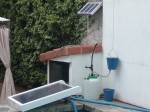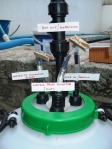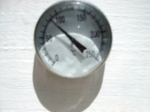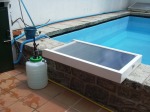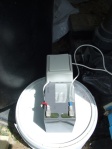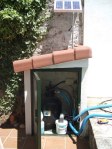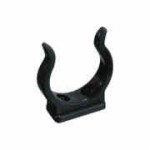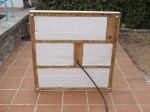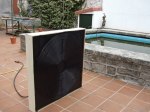Flate Plate Collector
 Having built a very low cost solar thermal collector to heat a small swimming pool I decided to build a more sophisticated flate plate collector linked to a direct domestic hot water system.
Having built a very low cost solar thermal collector to heat a small swimming pool I decided to build a more sophisticated flate plate collector linked to a direct domestic hot water system.
After some research looking at the different methods available I decided to build a one third size (about 0.6 square metres) collector using aluminum sheet, polystyrene insulation, silicone tubing, twin wall polycarb roofing and an outer frame of softwood.
Arguments about the relative efficiencies of flate plate collectors and evacuated tube collectors are a little cyclical and academic. My view is that in a ‘challenging’ climate like the UK an evacuated tube collector is probably best. I live in central Spain with significantly higher levels of solar radiation and, even in autumn and winter clear blue skies and so flate plate collectors are fine and cheaper..
Before deciding on exact sizes for your panel, do some research on the stock sheet sizes for the key components of the project. If you go over these standard sizes you will waste material and incur extra costs. Obviously the size of the flate plate collector is linked to you demand for hot or pre heated water but remember anything bigger than the ‘normal ‘ maximum size of 2m x 1m will weigh 35kg and above and becomes difficult to handle and fix on the roof. Mounting multiple panels can be a way of overcoming this problem.
I decided to make my panel 600mm x 1020mm (inner collector size) which is a little under a third of the size of a commercial panel. To make the project realistic I scaled down all of the components to the proportion of approximately a third. Ideally I wanted the frame to be aluminum or uPVC to eliminate maintenance and improve the appearance of the panel. The cost and difficulty finding anyone interested in making a simple rectangular frame in those two materials made this impossible so I decided to go for my ‘native’ material (timber). I am a joiner by trade.

I bought approximately 4m of 120mm x 40mm planed softwood (pine). This cost 40 euros which I think would have been significantly cheaper in the UK (20 quidish). The frame needs to be mitred on the top two corners and the joint at the bottom rail is a stopped housing joint. If joinery isn’t your strong point you could use butt joints with extra long screws or coachbolts. The idea of making the bottom rail 20mm narrower than the top rail is so that the twin wall polycarb cover slides into position rather than being fixed on all four sides. On balance this isn’t very important but it makes maintenance easier and I think it looks better.

After gluing and screwing your frame fix your 80mm polystyrene insulation so that it is flush (level with) the back of the frame. I fixed the insulation with a can of expanded polystyrene foam at a cost of about 6 pounds. Don’t go mad with the foam it expands to many times its volume and is a very strong glue. When the foam is dry, cut off the excess and tidy up the joints. My insulation was free of charge, liberated from a skip after it was used as packing for some metal roof panels being fixed near my house. The cost of a piece to insulate my panel would probably be around 15 pounds.
You should now have a very solid frame with a flush backside and a 40mm recess on the frontside. This recess is to accommodate: 1mm of aluminum; 7mm of slightly compressed 9mm silicone tubing; another 1mm of aluminum; 20mm airspace; 6mm of twin wall polycarb sheet and a small 4mm recess to improve appearance. Unless you can buy the aluminum sheet in exact sizes you will need to cut the sheets to fit your frame. A jigsaw with metal blade is probably easiest but you could cut it with heavy duty shears used for cutting lead and other sheet materials. Be careful, the edges are like razors. Use a file to tidy up the cut edges and be sure to wear gloves and a sturdy shirt with long sleeves for protection.
My first layer of aluminum fitted nice and snug and all I did was use some translucent silicone sealant around the perimeter to hold it in position. If you wanted you could use the silicone sealant in a grid pattern to ‘stick’ the sheet down. The reason for referring to silicone is that inside the collector (between the two sheets of aluminum and on the top surface of the top sheet of aluminum) the temperature will go over 150 degrees C. This would destroy ordinary polythene or plastic.

Now you have to position your ‘serpentine’ of silicone tubing. I paid about 50p per metre for mine and I have 15m in my panel. If you find some silicone tubing at a good price buy extra, it’s not easy to find. To form good bends at the ends of the runs without kinks you need to make some semi circular or circular formers out of something about 7mm thick. Plywood would be OK, I used the bottoms of plastic cups that were 70mm in diameter. I left mine in, they aren’t technically necessary but even when the heat distorts them the silicone tubing is held tight in position with the silicone sealer and being sandwiched between the two sheets of aluminum.
The diameter of the ends depends on your silicone tubing, mine wouldn’t go under 70mm diameter without kinking. Set out your grid pattern maximizing the amount of tubing and make sure you have the ‘in’ and ‘out’ tubes emerging from the corners of the bottom rail of your frame. You will need to drill two holes to let these two tubes out.
I used masking tape to temporarily hold the tubing in place and dots of silicone sealant to fix the tubing to the clean bottom sheet of aluminum. The colour of this sheet is irrelevant (I assume) but it should be clean of grease and oil. You will need to drill a small hole in the top rail of your frame to locate a simple meat thermometer. Make sure the probe on the thermometer (mine was 125mm) is in the void between the sheets and touches one or more silicone tubes. This is about as accurate as you will get for the internal temperature of the panel. The actual temperature of the water inside the tubing will be slightly cooler. I bought my thermometer on Ebay for 6 pounds but I’ve seen them in Wilko’s and Boyes for 3 pounds.
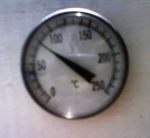
Remove all masking tape and dust and carefully mark on your top sheet of aluminum where you are going to screw the top sheet down onto the bottom sheet, slightly compressing the tubing. I used 12 – 20mmx 8 gauge flat headed screws. The screws don’t have to be self tappers, ordinary hard steel wood screws. Drill small pilot holes to maximize the grip you get when you tighten the screws.
Double check the position of the holes before you drill because if you pierce the silicone you will have to replace the whole serpentine, I don’t think a joint would survive the heat. Before you fix your top sheet give it two coats of matt black paint, preferably heat resistant, like the paint you would spray an exhaust or engine with. As you fix the top sheet down you will feel the tubing being slightly compressed, don’t go mad or you will strip the aluminum of the bottom sheet (its only 1mm thick). Having done this blow down the tube to check there are no kinks or obstructions then go and get a tea/coffee/beer.

I fitted a couple of small rubber door stops to protect the ‘in’ and ‘out’ tubes from being snagged or torn with moving the panel. The shaped ends of my frame also help to protect the tubes from damage and I think they look good.
All that remains now is to fit the cover. The cover is there to eliminate cooling breezes and keep out the weather and insects. I used twin wall 6mm polycarb sheeting and had to buy a whole sheet which cost 40 euros (about 35 pounds). This was 3 times more than I needed. Find somewhere that does cut to size to avoid waste and reduce costs. You could use ordinary 4mm glass but the disadvantage is that the weight would hugely increase the overall weight of the panel. The other disadvantage is the fragility of glass, a hailstorm of the sort we get in Spain would destroy the glass.
I used white plastic U section to fix the 6mm cover. Its best to use 8mm as 6mm may be very tight. Experiment a little with the U section and choose a section that is tight but not too tight. The U section cost me 6 euros for 2 x 2m lengths.
Fix the top and the two sides with small 12mm 4 gauge round headed screws, forming mitres at the corners. Work out where your cover will extend to (flush or just past the bottom rail) and mark the mitres so that the bottom piece of U section is fixed to the cover with silicone sealant. This makes it look nice and neat and it’s very easy to remove the cover for maintenance.
If you have calculated your sizes accurately you should have a 6mm step from the U section to the top of the frame. It’s not mandatory but the ‘joiner’ in me knows it looks much better set back in ‘reveal’ a little.
Assuming you have primed and undercoated your frame now it’s time to gloss it. I used ordinary white gloss. As far as the flat plate collector goes that is essentially it.

To test it, find a way of filling the panel, getting rid of any air bubbles. If you experiment with silicone and polythene tubing you will find a way to go from silicone to polythene. My 9mm silicone fits snugly inside 10mm polythene and if you use a short piece of 6mm microbore black irrigation hose you can use a standard car radiator hose clip to make the connection. Don’t use jubilee clips, they don’t work well below 12mm diameter tubing. The clips were off Ebay and cost about 1 pound each.
Your testing can be with pause/pump or continuous flow. I simply use a couple of clothes pegs and a funnel to fill the panel with cold water (about 15 degrees C) and place my panel in the sun.
Be careful! Not that this is as important in the UK but in southern Europe the panel becomes VERY hot VERY quickly. After 15 minutes from a start temperature of 20 degrees my panel was 70 degrees and after 30 minutes it was 90 degrees and rising quickly. If I had left the panel out there for 5 more minutes it would have blown the pegs off and boiled. When I released the pegs at about 95 degrees pressurized water and steam shot out nearly scalding me…
I estimate the surface temperature of the black top sheet of aluminum was about 120 or 130 degrees! This is really a warning about the consequences of a blockage or a pump or timer failure. Any components in contact with the internal parts of the panel must be able to withstand temperatures of at least 150 degrees C. I have seen temperatures quoted for flat panel collectors at 200+ degrees C. I think that is a little exaggerated, even in Spain.
Silicone is OK up to about 250 degrees C, polythene would melt.
I am currently testing the pause pump method and preliminary figures are that after 15 minutes in full sun I can pump for about a minute and move about half a litre of water at 55+ degrees. The quantity isn’t much but remember it’s a one third model of full panel.
Continuous pumping from 20 degrees raises the temperature to 35 degrees. Again you have to remember that once your tank is full the panel is heating pre heated water. It’s the first 2 or 3 hours from cold that takes the time.
My next blog entry will be how I capture my hot water and insulate it.

 Start point was 30L of well water at 15 degrees and I position my panel due South at about 35ish degrees of vertical inclination which i think was about right. One of the things I have noticed here in Spain is that panel orientation for thermal and PV panels is less important than in the UK. There is literally so much light and sun it makes only marginal differences if you are Southeast, Southwest, horizontal or 60 degrees. PV panels always perform better at correct orientations but my collector seems to work at any angle as long as it is somewhere pointing Southish…..
Start point was 30L of well water at 15 degrees and I position my panel due South at about 35ish degrees of vertical inclination which i think was about right. One of the things I have noticed here in Spain is that panel orientation for thermal and PV panels is less important than in the UK. There is literally so much light and sun it makes only marginal differences if you are Southeast, Southwest, horizontal or 60 degrees. PV panels always perform better at correct orientations but my collector seems to work at any angle as long as it is somewhere pointing Southish…..


